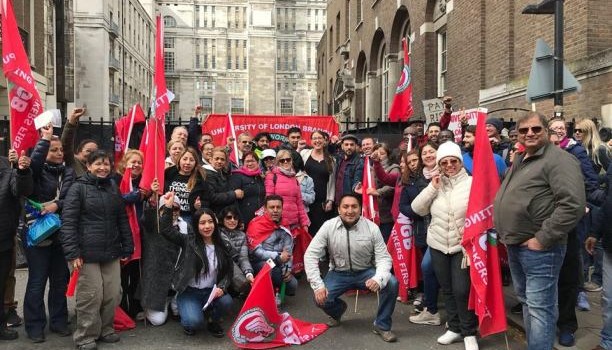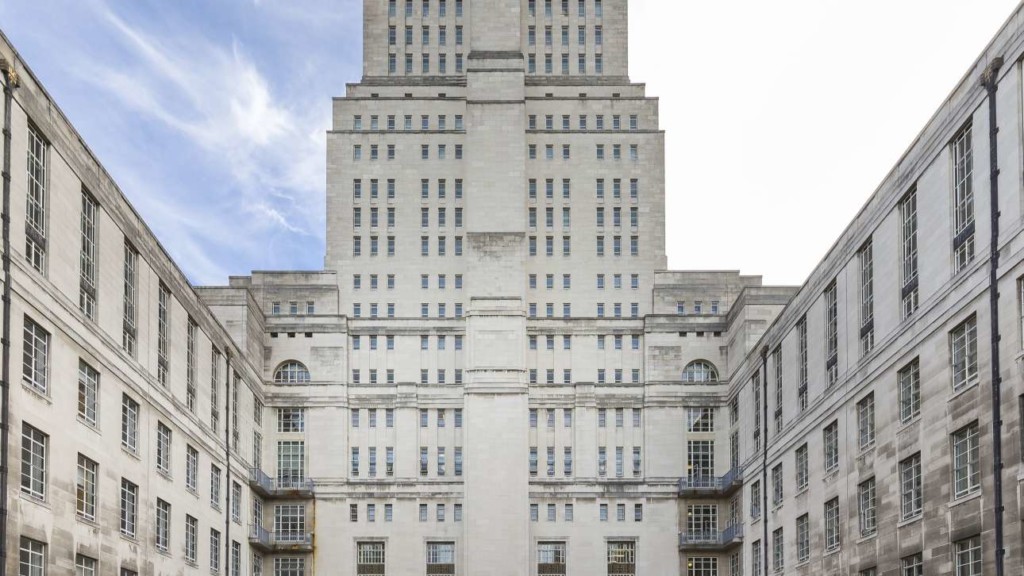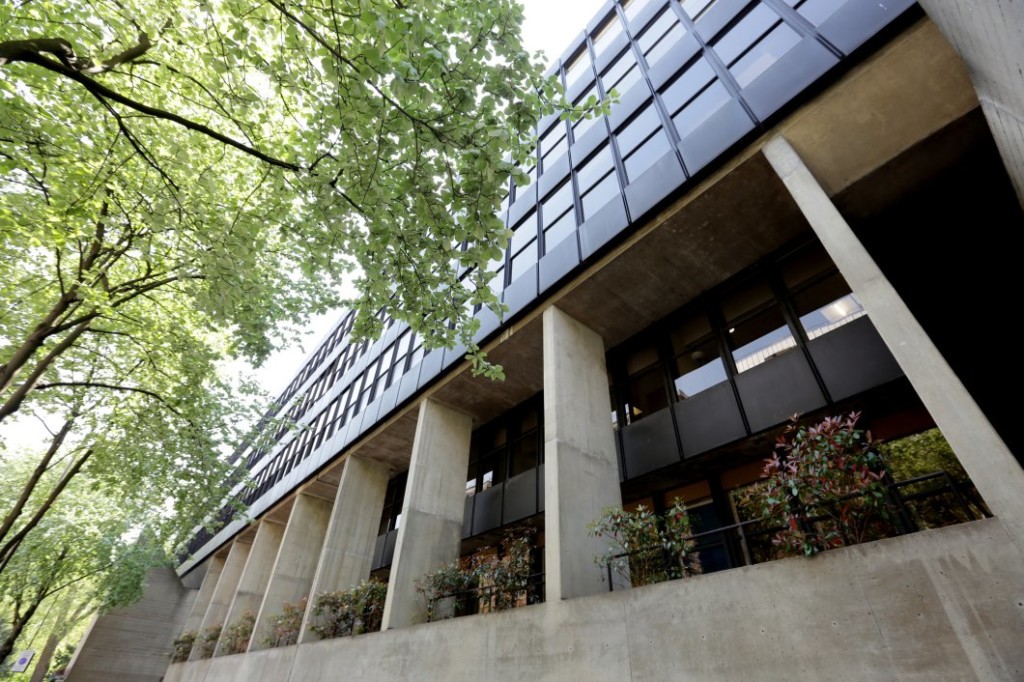Can the University of London afford to bring its workers in-house?

[responsivevoice_button]
Cleaners, security guards, catering staff and other workers at the University of London are campaigning to be directly employed by the university, rather than through outsourcing companies. University management says it cannot afford the extra costs that would involve. But a Corporate Watch investigation has found:
- the university has substantial cash reserves, with £45 million in the bank.
- financial problems used by management to argue against in-housing have been a direct result of their own expansion strategy.
- many of the staff at the consultancy chosen to review the costs of in-housing used to work for outsourcing companies.
- the university has refused our Freedom of Information request for a copy of that review. Similar reviews by other universities found in-housing would not be significantly more expensive.
We put our findings to the university. They did not dispute the figures but said the issues involved were “very complex” (full statement below).

University of London 2019 graduation, www.london.ac.uk
‘The dignity we deserve’
Around 250 staff working at the University of London are currently employed by four outsourcing companies rather than directly by the university itself.
The majority of outsourced staff are represented by the Independent Workers of Great Britain (IWGB) union. They say the jobs must be brought in house for two main reasons: workers are employed under worse conditions than in-house staff, with “worse pensions, holiday pay and sick pay entitlements”; and face “bullying, discrimination and illegal deduction of wages”.
The centrepiece of the campaign has been the boycott of the landmark Senate House library building. According to cleaner Margarita Cunalata: “We will continue fighting until we are made direct employees and treated with the dignity we deserve.”

Senate House, www.london.ac.uk
In response, the university management have agreed to bring around 35 audio-visual, front of house, post room staff and porters in house (just over 10% of the total outsourced workforce). They have also pledged to stop anyone being employed on zero hours contracts, another initial campaign demand. But there has been no commitment to directly employ the rest of the workers, merely a promise to review all outsourcing contracts by spring 2021.
The companies profiting from university outsourcing
Four different outsourcing companies are involved:
– Catering staff are employed by Aramark, a huge multinational food service company based in the US.
– Cleaners, security, audio-visual, porters, reception and post room staff by Cordant Group, a UK outsourcing firm.
– Gardeners by Nurture Landscapes, a “horticulture, landscape and grounds maintenance business”.
– Maintenance staff by Bouygues, a multinational construction, development and telecoms company based in Paris.
The university argues that outsourced staff benefit from “job flexibility” and from higher take home pay as they have to make comparatively lower pension contributions.
They also say employing staff directly will be too expensive. In a statement to university staff, vice-chancellor Peter Kopelman said analysis commissioned by the university showed bringing staff in house would cost substantially more “at a time when we are currently projecting an operating budget deficit for this academic year”.
This is what we’re looking at here. The key question is not whether outsourcing costs the university less – it may well do. It is whether the university can afford to do the right thing and give the workers the same terms and conditions as other university staff.
Two questions
A disclaimer before we continue: it is impossible to definitively answer the question above with the information currently available. The university refuses to disclose the detail of its calculations around the cost of in-housing. And its annual financial statements in the main only give top-level numbers. But they do give a good picture of the overall financial health of the institution.
So, two questions: how is the university doing financially? And how do the university’s claims over the cost of bringing staff in house stack up?
For the first, let’s start by breaking down the costs of in-housing into two parts:
- one-off set-up costs involved in setting up new management and administrative structures for the newly in-housed staff, such as – supervision, payroll, recruitment, procurement and facilities.
- any extra regular costs of running the services in-house. For example, due to the workers getting a better deal, or due to the need for more supervisors, managers, HR staff, plus direct procurement of materials and so on.
These of course have to be set against the profit margins the companies are making on the contracts. More on that below.
There is plenty of cash in the bank
A look at the university’s latest financial statements suggests it could certainly afford the set-up costs. The accounts for the year ending 31 July 2018 showed the university had £45 million cash in the bank.
It’s true this is less than previous years and that the university’s debts are now bigger than the cash it has to hand.i But this is because management has been splurging cash on an ambitious expansion strategy.
In the last two years for example, £20 million was spent on “capital expenditure”, including refurbishments of Senate House and Charles Clore House, a new distance learning programme, IT systems and “improving and upgrading teaching and research infrastructure”.

Charles Clore House, www.london.ac.uk
University management say this investment will help to make more cash for the university, which will make it more financially sustainable. But clearly the money is there to cover the set up costs of employing staff in house. And if the management’s strategy does make the university more financially sustainable, they can more easily satisfy the cleaners, caterers and security guards’ demands for better treatment.
The accounts also show that, as well as cash in the bank, the university has £11 million in its “Unified Trust Fund”, plus over £90 million thanks to endowments. It also owns prime London property worth around half a billion pounds. Add up everything the university owns, then take off what the university owes to its “creditors” – most notably a £50 million loan from RBS – and the university’s net worth is £646 million.
The university’s deficits have been caused by management’s decisions
What about the budget deficit described by vice-chancellor Peter Kopelman above? The university may own central London property and have multi-million pound endowments, but it is unlikely to sell its main buildings and the endowments are almost all restricted to academic work. Meanwhile, it is losing money on its day to day operations – and so reluctant to add to its costs by bringing staff in house.
But the university has only started to make deficits after it embarked on the management’s much-vaunted five year expansion plan, starting in 2014:
| Surplus/deficit (£m) | |
| 2017/18 | 2.3 |
| 2016/17 | -0.5 |
| 2015/16 | -3.7 |
| 2014/15 | 1.6ii |
| 2013/14 | 7.5 |
| 2012/13 | 4.9 |
| 2011/12 | 4.6 |
| 2010/11 | 4.1 |
Annual reports since 2015 explicitly state that weaker financial performance was due to the increased costs involved in the 2014-19 University Strategy. The 2016 report states, for example:
“The decision to make a deficit at the ‘operating level’ in 2015-16 is a direct consequence of the University Strategy”
One of the main goals of the five year plan was financial. It aimed for an operating surplus of as much as £9 million by 2019 but as we saw above, Peter Kopelman predicts another deficit for the coming year.
It’s notable that before this new direction, the university had been posting healthy surpluses – between £1 million and £8 million in the four years between 2014 and 2011, the last set of financial statements available on the university’s website. That averages out at just under £5 million a year.
So if the strategy does turn out to be successful, then the university will have the financial leeway to employ staff directly (as the surplus will be big enough to absorb the extra costs).
If it’s not successful then, from a financial point of view, the management’s much-vaunted investment plan has been a dud and has left the university in far worse financial health. In which case the university could have afforded to bring staff in house had it been managed better.

Peter Kopelman, www.london.ac.uk
Will bringing staff in house cost an extra £3 million a year?
In his public statement, vice chancellor Peter Kopelman said analysis commissioned by the university “had estimated the additional annual cost of bringing in house all currently contracted out services on a like for like basis to be around £3 million”.
This is in sharp contrast to the findings of similar reviews at other universities. A 2016 review by the Association for Public Service Excellence, commissioned by the School of Oriental and African Studies – itself a University of London member institution and located a stone’s throw away – found bringing cleaners in-house there should be “cost neutral” after initial set-up costs (the university agreed to bring its cleaners in-house last year).
Queen Mary – also a University of London member – brought cleaners in house ten years ago. A review soon after found that while “the real and estimated costs for the service had risen slightly above those involved in the past, these increases were marginal and the Chief Administrative Officer declared himself to be ‘perfectly happy’ with the cost rises so far.”
The review also found the cleaners themselves were “overwhelmingly positive about their new jobs”, due to “the increased pay and benefits, as well as working for the College with better management and opportunities for career development”.
In general, while in-housing sees staff get better conditions and increases university management and administration costs, it cuts out the profit margins being made by the outsourcing companies (there are also extra costs involved in contracting these companies and overseeing their work).
We do not know how much is being made on individual outsourcing contracts with the university as companies do not disclose that level of detail. But the accounts of the relevant subsidiaries registered at Companies House show they are making healthy profits from their services overall. The following table shows the revenues, ‘gross profit’ (which shows the profit they made directly from their various contracts), and the profit ‘margin’ for each company:*
| Revenues (£m) | Gross profit (£m) | Margin (%) | |
| Aramark Ltd | 272 | 54 | 20 |
| Cordant Security Ltd | 93 | 8 | 8 |
| Cordant Cleaning Ltd | 60 | 4 | 7 |
| Nurture Landscapes Ltd | 36 | 11 | 20 |
| Bouyges E&S FM Ltd | 171 | N/A | N/A |
* Security, AV, porters, postroom and reception staff employed by Cordant Security Ltd, cleaners employed by Cordant Cleaning, both part of the Cordant Group. Note also the results quoted above are just those from the subsidiaries employing the University of London workers. Aramark, Cordant and Bouygues are all huge corporations with far greater overall revenue and profits when all their operations around the world are included.
Admittedly there are a greater number of staff, and a greater number of job types, to be brought in house at the University of London. There were just around 100 cleaners at Queen Mary for example.
But could those differences explain the supposed cost of £3 million extra per year? The problem is, it is impossible to know how that sum has been calculated, because the university refuses to share the review. The university rejected our freedom of information request for a copy, saying disclosure would be “prejudicial to the conduct of public affairs”.
Who’s behind the figures?
The review was produced by an organisation called the Russell Partnership, which describes itself as the “UK’s leading Strategic Food and Technology Consultancy with over 600 global clients”. These include a range of universities and companies, plus events such as the Olympics and the Rugby World Cup.

Many of the Partnership’s staff come from the outsourcing industry. Founder and Chairman David Russell was “Group Managing Director of Europe’s largest private catering company”. Of the ten “consultants” listed on their website, two used to work for outsourced catering giant Sodexo, one for the rival Compass Group, one for Italian multinational catering company Autogrill Spa, with another for an unnamed “Outdoor Event Catering company”.
One former employee, Jan Matthews, worked for Aramark, the same US multinational that holds the catering contract at the University of London.
Of course, we do not how relevant these links are. Were the consultants with catering industry experience involved in the University of London review? If so, did that experience encourage them to look more favourably at the relative benefits of outsourcing?
The only way to know is for the University to publish the report.
We asked the University of London why it chose a consultancy with links to the outsourced catering industry to perform its review of outsourced services (including catering). It did not answer.

Chief Operating Officer Chris Cobb, www.london.ac.uk
Management are paid well enough to bring staff in house
As well as cost, outsourcing saves the management time and hassle. IWGB President Henry Chango Lopez, who used to be a porter at the University of London, said when the campaign launched: “Every time we go to the university to complain about poor pay or conditions, they hide behind the outsourcing companies and say it isn’t their responsibility.”
But the accounts show management are paid well enough to stomach any extra work involved. According to the latest financial statements, 11 members of staff enjoyed basic pay of over £100,000 in 2018. The seven lucky members of the “Vice Chancellor’s Executive Group” between them made £1.1 million.
Then-vice-chancellor Adrian Smith’s salary was £168,000 and he wasn’t even the best paid manager. The – unnamed – highest paid member of staff made between £220,000 and £225,000. This is presumably Chief Operating Officer – and prime outsourcing advocate – Chris Cobb.
That puts him on over 11 times as much as the university’s cleaners.
In response to the points above, a university spokesperson said:
“Since the 2014-19 strategy was written there have been a number of changes in the environment in which the University operates. There are a rising level of adverse factors that are likely to impact the University and its federal members. The University of London is not alone in facing these pressures – most higher education institutions are operating in a challenging financial environment.
“The University Strategy 2014-19 is one of investment vital for the long-term sustainability and success in the challenging years ahead.
“Your questions suggest an overly simplistic approach to a very complex set of issues. We have already started the process of bringing staff in house and are on track to bring front of house, portering and post room services back in-house by the end of May 2019.
“We will apply the same process in turn to the other externally contracted services and expect this to be completed by 2020.iii
“The plans are responsible and appropriately phased to assure no disadvantage to staff, no deterioration in service standards and additional costs to be spread over more than one financial year.”
(We checked and the “process” to be completed by 2020 is the review of outsourcing services already announced.)
CORRECTION 6/9/19: The article originally stated the university spent £20 million to buy land in Stratford for new halls of residence. This has been removed. Vice chancellor Peter Kopelman has since said the University Partnerships Programme – the for-profit company the university is developing the halls with – provided the cash to buy the land.
i So-called “net debt”, a financial measurement – basically take away all your cash and cash equivalents from all your debt.
ii The following year’s accounts – for 2015/16 – show a deficit for 2014/15 of £4.8 million. This appears to be because of a change in the accounting standards followed by the university.
iii IWGB representatives told us the catering contract is set to be reviewed by 2021.
